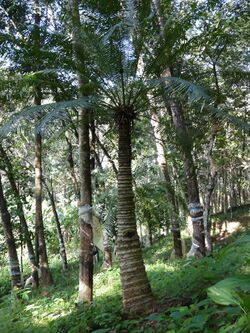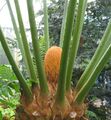Biology:Cycas circinalis
| Queen sago | |
|---|---|

| |
| In Kerala | |
| Scientific classification | |
| Kingdom: | Plantae |
| Clade: | Tracheophytes |
| Clade: | Gymnospermae |
| Division: | Cycadophyta |
| Class: | Cycadopsida |
| Order: | Cycadales |
| Family: | Cycadaceae |
| Genus: | Cycas |
| Species: | C. circinalis
|
| Binomial name | |
| Cycas circinalis | |
Cycas circinalis, also known as the queen sago, is a species of cycad known in the wild only from southern India. Cycas circinalis is the only gymnosperm species found among native Sri Lankan flora.
Taxonomy
C. circinallis is native to southern India and Sri Lanka, but the species name was formerly widely used for similar cycads in Southeast Asia, which leads to confusion in modern sources. The specimens described as "C. circinallis" in Indonesia and New Guinea are now recognized as Cycas rumphii; while the taxon formerly described as the subspecies C. circinallis ssp. riuminiana from the Philippines is now regarded as a separate species, Cycas riuminiana.[2][3]
Cultivation
The plant is widely cultivated in Hawaii, both for its appearance in landscape and interiors, and for cut foliage.[4]
Young shoots
Use as food
The seed is poisonous. The potent poison in the seeds is removed by soaking them in water. Water from the first seed-soaking will kill birds, goats, sheep and hogs. Water from the following soakings is said to be harmless. [Minimum of 5 Soakings needed to ensure the safety]
After the final soaking, the seeds are dried and ground into flour. The flour is used to make tortillas, tamales, soup and porridge.
Lytico-bodig disease
The plant was thought to be linked with the degenerative disease lytico-bodig on the island of Guam; however, the cycad native to Guam has since been recognised as a separate species, Cycas micronesica, by K.D. Hill in 1994.
Chemistry
Leaflets of C. circinalis contain biflavonoids such as (2S, 2′′S)-2,3,2′′,3′′-tetrahydro-4′,4′′′-di-O-methylamentoflavone (tetrahydroisoginkgetin).[5]
References
- ↑ Varghese, A.; Krishnamurthy, V.; Garnesan, R.; Manu, K. (2010). "Cycas circinalis". IUCN Red List of Threatened Species 2010: e.T42089A10627275. https://www.iucnredlist.org/species/42089/10627275. Retrieved 26 June 2022.
- ↑ Lindstrom, Anders; Hill, Kenneth; Stanberg, Leonie (15 February 2008). "The genus Cycas (Cycadaceae) in The Philippines". Telopea 12: 119–145. doi:10.7751/telopea20085805.
- ↑ Lindstrom, Anders; Hill, Kenneth; Stanberg, Leonie (26 October 2009). "The genus Cycas (Cycadaceae) in Indonesia". Telopea 12 (3): 385–418. doi:10.7751/telopea20095826.
- ↑ "King and Queen Sago". University of Hawaii. October 1988. http://scholarspace.manoa.hawaii.edu/handle/10125/6011.
- ↑ Phytochemical Investigation of Cycas circinalis and Cycas revoluta Leaflets: Moderately Active Antibacterial Biflavonoids. Abeer Moawad, Mona Hetta, Jordan K. Zjawiony, Melissa R. Jacob, Mohamed Hifnawy, Jannie P. J. Marais and Daneel Ferreira, Planta Med., 2010, 76(8), pages 796-802, doi:10.1055/s-0029-1240743
External links
- Floridata: Cycas circinalis
- EDIS: Queen sago
- USDA Plants Profile
- University of Hawai'i at Manoa: King and Queen Sago
Wikidata ☰ Q161198 entry
 |









